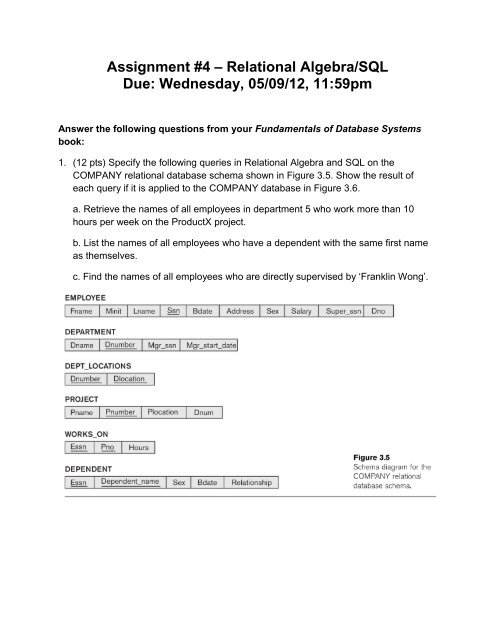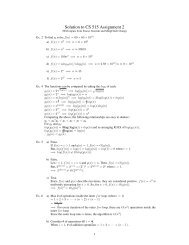Assignment #4 â Relational Algebra/SQL Due ... - Classes
Assignment #4 â Relational Algebra/SQL Due ... - Classes
Assignment #4 â Relational Algebra/SQL Due ... - Classes
You also want an ePaper? Increase the reach of your titles
YUMPU automatically turns print PDFs into web optimized ePapers that Google loves.
<strong>Assignment</strong> <strong>#4</strong> – <strong>Relational</strong> <strong>Algebra</strong>/<strong>SQL</strong><br />
<strong>Due</strong>: Wednesday, 05/09/12, 11:59pm<br />
Answer the following questions from your Fundamentals of Database Systems<br />
book:<br />
1. (12 pts) Specify the following queries in <strong>Relational</strong> <strong>Algebra</strong> and <strong>SQL</strong> on the<br />
COMPANY relational database schema shown in Figure 3.5. Show the result of<br />
each query if it is applied to the COMPANY database in Figure 3.6.<br />
a. Retrieve the names of all employees in department 5 who work more than 10<br />
hours per week on the ProductX project.<br />
b. List the names of all employees who have a dependent with the same first name<br />
as themselves.<br />
c. Find the names of all employees who are directly supervised by ‘Franklin Wong’.
2. (16 pts) Specify the following queries in <strong>Relational</strong> <strong>Algebra</strong> and <strong>SQL</strong> on the<br />
database schema of Figure 1.2 (see below).<br />
a. Retrieve the names of all senior students majoring in ‘CS’ (computer science).<br />
b. Retrieve the names of all courses taught by Professor King in 2007 and 2008.<br />
c. For each section taught by Professor King, retrieve the course number, semester,<br />
year, and number of students who took the section.<br />
d. Retrieve the name and transcript of each senior student (Class = 4) majoring in<br />
CS. A transcript includes course name, course number, credit hours, semester, year,<br />
and grade for each course completed by the student.<br />
3. (12 pts) Write <strong>SQL</strong> update statements to do the following on the database schema<br />
shown in Figure 1.2 (see below).<br />
a. Insert a new student, , in the database.<br />
b. Change the class of student ‘Smith’ to 2.<br />
c. Insert a new course, .<br />
d. Delete the record for the student whose name is ‘Smith’ and whose student<br />
number is 17.<br />
4. (60 pts) Project Development<br />
(30pts) Write the <strong>SQL</strong> scripts to create and populate corresponding entities and<br />
relations (with at least 4 records in each) to the ER diagram you have created for<br />
you real-world application from <strong>Assignment</strong> #3. Make sure you include the primary<br />
and foreign keys, as well as what to do on updates and deletions. If your translation<br />
cannot capture some constraints in the ER diagram, explain why.<br />
(30pts) Review the list of requirements for the operation/functionality of your<br />
database that you wrote in <strong>Assignment</strong> #3. This list will influence the user-driven<br />
questions/queries for your database. Develop this list of questions/queries in<br />
English, and then use relational algebra and My<strong>SQL</strong> statements to answer the<br />
questions that you have pointed out as important questions for your real-world<br />
application.<br />
These questions are user-driven rather than system-driven. For example, a systemdriven<br />
question can be "select all the rows from the employees table". In contrast, a<br />
user-driven question can be "identify all the transactions committed yesterday with<br />
an amount bigger than $100". Write a list of user-driven questions for your<br />
application, along with the relational algebra and <strong>SQL</strong> statements that implement<br />
these user-driven questions.

















